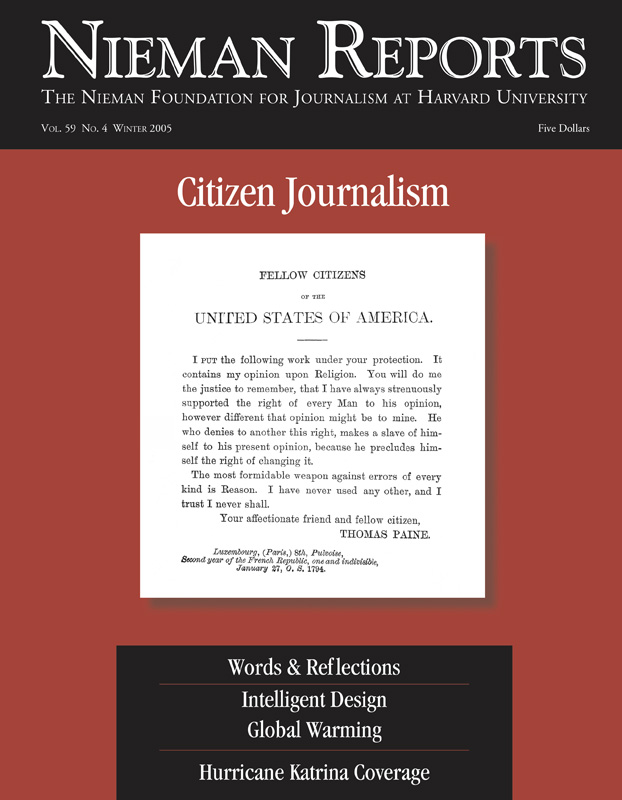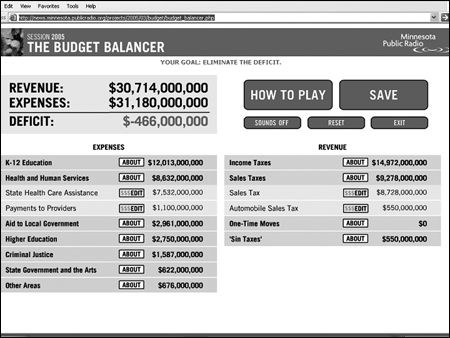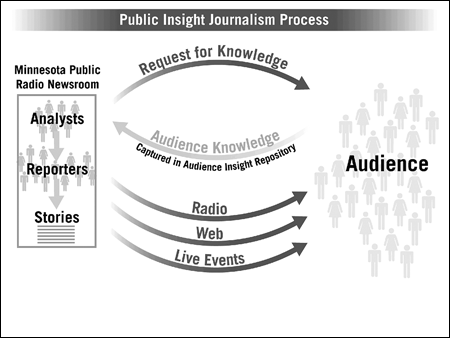
Citizen Journalism
With the arrival of the Internet, the ability of nonjournalists to “publish” their words and link them with those of other like-minded scribes has altered forever the balance of power between those who control the means to publish and those who have something they believe is important to say. This shift from journalists as gatekeepers to citizens as reporters has profound implications for news organizations that “might have completely underestimated the influence of this new medium.”

This Minnesota Public Radio Web page gave people the information necessary for them to try to balance the state’s budget and explain their choices. From those plans and comments story assignments were made by newsroom staff. Graphic supplied by Michael Skoler.
Bringing the public into the newsroom is dangerous. Longtime colleagues have been ready to stab me with the nearest implement over dinner when I mention changes at Minnesota Public Radio/American Public Media. I have been quietly advised to stop making statements like, “On any given story, someone in our audience is bound to know more than even our most experienced reporters and editors.” And I understand why.
That statement sounds downright disrespectful to the people who put their blood, sweat and passion into digging up the news and making sense of it for the public. Sure, involving the public in newsgathering sounds friendly and inclusive at conferences on the future of journalism. But in the newsroom, it can feel like a hook to the jaw.
For so long, journalists have considered themselves the arbiters of the news for “the great unwashed,” as one colleague half-jokingly puts it. For so long, journalists have seen their Rolodex of powerful sources as a measure of their worth. The idea of including the public, day in and day out, in newsgathering seems like pandering to public opinion at best and abandonment of our mission to inform and of our journalistic values at worst.

Graphic supplied by Michael Skoler.
Bringing in the Audience
Yet my experiences at Minnesota Public Radio (MPR) convince me that we should fight past our gut reactions. Working with the audience can reinvigorate journalism, open the newsroom to more diversity than we could ever achieve through hiring alone, and break the media’s overreliance on officials and expert spokespeople who try to manage the press.
The MPR newsroom has invested nearly three years in defining a new way of working we have dubbed “Public Insight Journalism®.” We’ve built software that keeps track of more than 12,000 public sources who share their expertise and experience. We’ve hired “analysts” to manage and mine those relationships. We’ve held meetings in people’s homes and at community centers. We’ve invited regular folks into studios and mobile recording booths. And we’ve run gaming software on our Web site. All this interaction is aimed at tapping the knowledge and insights of the public to make our reporters and editors and coverage even smarter and stronger.
Our rallying cry to the public has been “share what you know.” We don’t want opinion, we want knowledge. And we have amassed our public-source network over time by asking people to help us with specific stories and issues, using our airwaves and Web site to reach and engage them. With an audience of more than 500,000 listeners, MPR News continues to develop this network. We have avoided using our tools to do pseudoscientific online polls or collect person-on-the-street reactions. Instead, we actively look for public sources who have firsthand knowledge, whether it comes from their jobs, their hobbies, their relationships, or their life experiences, on stories that interest us or would interest us if we knew about them.
Expanding Our Sources
At the simplest level, the Public Insight Journalism (PIJ) process expands a journalist’s Rolodex, finding sources that would be hard to find. When MPR reporter Tim Post heard a couple of hunters complaining how more and more landowners were cutting off access to hunting land, Post wondered if this shrinking access was a trend. A public insight analyst sent e-mail surveys to those in our source network who had listed hunting as a “passion” or lived near prime hunting areas. The informal hunters network then kicked in.
Within a day or two, Post had nine new sources from e-mails. He followed up, added other sources, confirmed the trend, and wrote a story on growing disputes between landowners and hunters and among hunters themselves, over access to hunting land. A few weeks later, a St. Paul man named Chai Vang killed six hunters in Wisconsin in what started as a dispute over a deer stand but also had racial overtones. That shooting became national news.
This fall, we used PIJ to deepen our coverage of the mechanics’ strike and bankruptcy of Minnesota-based Northwest Airlines. On the air, MPR News hosts asked listeners to call a toll-free number or fill out an online survey to share their experiences as passengers, Northwest employees, former employees, or replacement workers. MPR analysts handed out cards at the airport explaining how to contact the newsroom and posted links to our survey on online bulletin boards and chat rooms popular with airline staff. They sent e-mails to those in our public source network. Nearly 200 responded.
For weeks, MPR analyst Melody Ng verified new sources, confirmed information, and passed vetted leads to reporters, editors and talk show producers. One source tipped us off to an FBI investigation into possible crew tampering—a story we confirmed and broke. An FAA inspector offered us access to an online database for tracking aircraft maintenance problems. Sources helped us track and report on passenger service problems and provided leads for many stories.
With successes like these, MPR reporters and editors who were originally skeptical have welcomed PIJ for its expanded source network. “It vastly speeds up the process of collecting information and sources,” says reporter Dan Olson. “And it gives more credibility to the reporting because it draws on many more voices.” Our reporters have access to an extra Rolodex of thousands of public sources with known expertise and the viral web of connections these people have via the Internet.
Yet this expanded Rolodex is a fairly rudimentary use of PIJ, made possible by linking knowledge management software with today’s fast online communications. To me, the real promise of PIJ lies in using public insight to help frame stories and set a distinct coverage agenda. The audience can guide us to important stories that are happening outside the controlled leaks and made-for-media events organized by vested interests. The audience can get us beyond our own social networks. And they can give us perspectives unfiltered by experts.
Reporting From the Bottom Up
In the fall of 2004, as macroeconomic numbers showed the nation had entered a recovery, MPR business reporter Jeff Horwich wanted to see if Minnesotans had felt the effects yet. Instead of surveying business leaders and economists, our newsroom sent e-mail surveys to 500 sources in our public insight network. We asked 1. if they had experienced the recession, 2. if they had experienced the recovery, and 3. what signs they saw of an economic recovery.
Seventy-six (15 percent) of the e-mail surveys were returned, coming from teachers, government employees, small business owners, high-tech workers, blue-collar workers, and entrepreneurs. The responses gave us a sort of topographic map of the economic landscape showing where the recovery was gaining traction, where it was stalled, and where the recession was still deepening.
The idea for one short piece on the recovery turned into a weeklong series on the uneven recovery, including an hourlong talk show. Public insight framed the series and revealed trends that economists couldn’t see. Reporters used the information as a starting point, rounded out their reporting with other sources and experts, and more than 20 public sources ended up on the air. Our reporting was praised by the competition for exposing and explaining the wildly varying impact of the recovery. It was a story our audience revealed to us. They made the series stronger, and they made us sound smarter.
Another experience with PIJ: In the last two budget cycles of the Minnesota legislature, MPR offered an online “Budget Balancer” where people could create their own balanced budgets from dozens of options and explain their choices. MPR’s Senior Analyst Andrew Haeg led the project. He analyzed the thousands of plans submitted and read every comment and then used that detailed look into how people thought through the budget debate to suggest story assignments.
For example, in the balancer many people used sin taxes to balance the budget, which had not been part of the budget debate. That led us to do a story on these taxes, like the tobacco tax, well before the governor and legislators shifted their focus and settled on that option. The newsroom also used a scientific poll to confirm a surprising trend we saw in the Budget Balancer—that Minnesotans, mostly opposed to tax hikes in principle, were willing to raise taxes to avoid specific spending cuts.
Then there’s the “Idea Generator”—an online collaborative tool we created to let the audience inform and strengthen our coverage of the educational performance gap between white and minority students. We have since used it to gather hundreds of ideas and leads for coverage of low high school graduation rates and the risks to small town survival.
But in honesty, while MPR has made great headway, PIJ has had a tough road to acceptance in the newsroom. One reason is that PIJ grew out of a management vision, not a perceived need by reporters and editors to increase their sources or connection to the audience. Another is that we have defined it by doing it, which has left some of us confused at times.
Opening the Priesthood
The real challenge beckons. Public Insight Journalism, if successful, should change us journalists, and not superficially. I don’t believe mainstream news organizations will create a new and better journalism simply by turning over the microphone or pen to citizens. What we need to do is listen, collaborate and learn from the knowledge in our audience. Sometimes this means turning over the microphone or pen, or letting people talk back through the Web, or Webcasting editorial meetings. But it really means opening up.
The online media revolution that has brought us blogs, citizen journalism and Wikis, is an assault on a traditional newsroom culture that Patrick Dougherty of the Anchorage Daily News described as a “priesthood, delivering truth to the masses” in the last issue of Nieman Reports. Used well, online tools can open the newsroom to more input, more diverse voices, and more questioning of our editorial instincts. But we have to change how we make coverage decisions if we are going to let insight from the public affect us. And that is hard, really hard, because it challenges our image of the profession and ourselves as authorities on the news.
The need to remake our culture is why many wonder if mainstream journalism can change fast enough to survive the online revolution. And why the board and senior management at Minnesota Public Radio/American Public Media have made Public Insight Journalism a strategic priority—one we hope to share widely with other media as we figure it out.
Michael Skoler, a 1993 Nieman Fellow, is managing director of news, Minnesota Public Radio/American Public Media.


